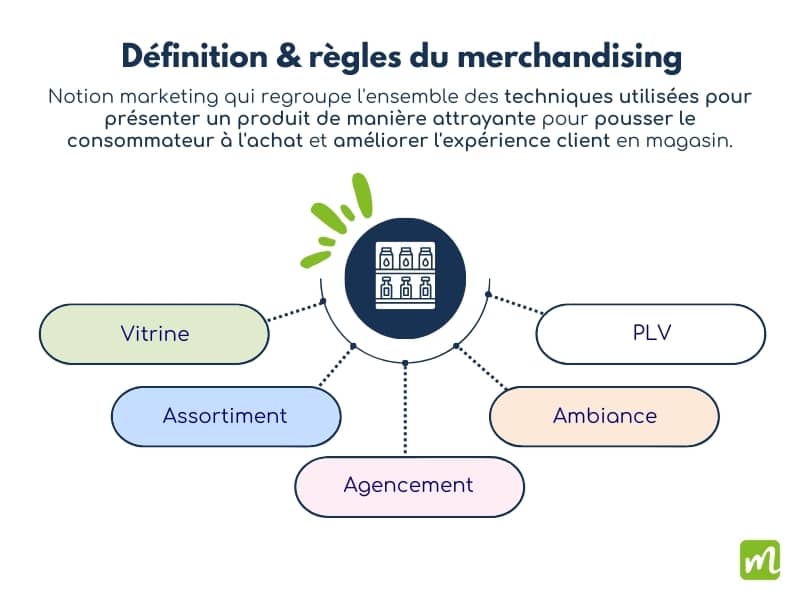Merchandising definition / Merchandising def
Here’s a simple definition of merchandising:
- Merchandising is a marketing concept that brings together all the techniques used to present a product or service in an attractive way, to encourage consumers to buy and improve the in-store customer experience.
The aim of merchandising is to maximize sales by drawing customers’ attention to the products you offer. To achieve this goal, you can use commercial merchandising software.
The 5 main aspects of merchandising are :
- the window,
- layout,
- the range,
- atmosphere,
- POS (point-of-sale advertising),
- Etc.
Merchandising can also include sales promotion techniques such as special offers, discounts and free gifts.
Merchandising can also be applied to Internet purchasing, with the optimization of online stores: this is known as e-merchandising.

What does merchandising mean? Merchandising definition and translation
“Merchandising” doesn’t really translate into French: we say “merchandising”. Some people also say “marchandisage”, although this term is less widespread.
Why merchandising? Merchandising objectives
The main aim of merchandising is to attract customers and encourage them to buy your products rather than those of the competition.
That’s why it’s important for salespeople to understand merchandising techniques, and to work with stores to ensure that their products are presented attractively and effectively.
As a sales agent or salaried salesperson for a brand, merchandising is important for several reasons:
Optimizing sales
Strengthen brand awareness
Stand out from the competition
Are products presented in accordance with the planogram? Is the brand’s DN respected? Are any products missing from the shelves?
What are the different types of merchandising?
To fully understand the definition of merchandising, you need to know that there are 3 types of merchandising:
- Management merchandising is the optimization of sales space and inventory management. An example of management merchandising is the organization of products in the store, monitoring stock levels, and managing the ordering and receiving of goods. This is based in particular on the analysis of sales data and customer buying behavior, in order to understand which products are the most popular and how to present them optimally at the point of sale.
- Organizational merchandising concerns the way products are presented in the store. For example, arranging products on shelves so that they are easily accessible and visible to customers. The aesthetic aspect of the presentation must be taken into account, using colors, textures and lighting to create a pleasant atmosphere conducive to purchasing.
- Seductive merchandising concerns the way products are presented to entice customers to buy. For example: promotions, price reductions, free gifts and specific staging to create a sense of urgency and appeal around products.
Examples of merchandising
To fully understand the definition of merchandising, we can look at different examples and strategies.
Of course, merchandising takes different forms depending on the type of outlet.
Example of a supermarket brand strategy
In supermarkets, for example, strategies vary from department to department, as consumer needs and expectations vary. There are many strategies, techniques and areas that stores (supermarkets, small boutiques, etc.) use to optimize their sales.
However, competition is fierce in the supermarket sector, and the travelling salesperson or merchandiser has to convince the department manager to allow him or her to put these different elements on the shelves. For example, supermarkets use cross-selling, “zone” structuring and POS tools.
A superb example of merchandising strategy in supermarkets would be the one recently carried out by Haribo, who were able to study consumer expectations to bring them what they were looking for: greater clarity. Following their approach, launched in 2021, in-store sales are said to have risen by 6%.

Example of IKEA merchandising strategy (furniture & decoration)
It’s impossible to talk about the best merchandising strategies without mentioning the genius of IKEA stores.
To encourage consumers to buy, the Swedish giant redoubles its creativity and formidable psychological techniques.
IKEA stores are an excellent example of a merchandising strategy that is 100% customer-focused.
Labyrinthine construction, loss of the notion of time, location on the outskirts of towns, restaurant just outside the store… Everything has been designed to encourage consumers to immerse themselves in the world of IKEA, and to indulge themselves.

For a beauty/perfumery boutique
Let’s change atmosphere with an example of a beauty/perfumery boutique. Here, the in-store experience is designed to offer a unique journey and reinforce brand loyalty.
An excellent example of merchandising strategy for a small boutique in this category is that of Rituals, which strives to offer its customers a sensory voyage… but not only that.

Merchandising rules in the 50s: Kepner's 5Bs (or 6Bs)
A veritable science, merchandising has been shaped by numerous researchers and practitioners, who have influenced the rules that most merchandisers use to optimize their merchandising strategy.
Among the most important are Charles H. Kepner’s 5B ‘s in his book “Modern Supermarket Operations” (although today we talk more about the 6B’s). The principle is as follows: to be effective and lead to a sale, a merchandising strategy must meet 6 criteria:
- Sell the right product,
- In the right place,
- At the right time,
- At the right price,
- With the right amount,
- With the right information.
Merchandising rules for the modern age: 5 aspects of merchandising
Today, the various aspects of a merchandising strategy that need to be optimized are considered to be :
- The range,
- Allocation of space to each product and brand,
- Point-of-sale layout,
- Product enhancement,
- Point-of-sale communication.
What are the pillars of merchandising?
Another essential point in the definition of merchandising: the pillars of merchandising.
The pillars of merchandising are the key elements of an effective point-of-sale product presentation strategy.
Visibility
Products must be arranged in such a way as to optimize their visibility at the point of sale, i.e. to be easily spotted by customers.
In a department where several products are competing for the consumer’s attention, how can you make sure your product is the most attractive? The first to be seen? That’s the whole point of visibility merchandising!
A variety of tools can be used: displays, labels, POS, role-playing or other high-quality visual presentations.
Accessibility
Accessibility is the second pillar of merchandising. Customers need to be able to easily find the products they are looking for. So products are arranged logically and clearly, with well-organized shelves and clear signage to help customers find what they’re looking for.
For example, with effective shelf markings: posters, floor markings, POS, shelf dividers, gondola headers…
Relevance
When was merchandising invented?
Merchandising came into being with the rise of self-service sales areas.
Merchandising techniques originated in the USA in the 50s, and arrived in our European department stores later, from the 70s onwards.
What is the Mercator definition of merchandising?
According to the Mercator marketing dictionary, merchandising is the set of “methods and techniques for the layout and presentation of products in stores, to increase the sales and profitability of these products.”
What other terms are linked to the definition of merchandising?
There are many different terms that can be used to define merchandising, such as cross-merchandising, e-merchandising and visual merchandising.
